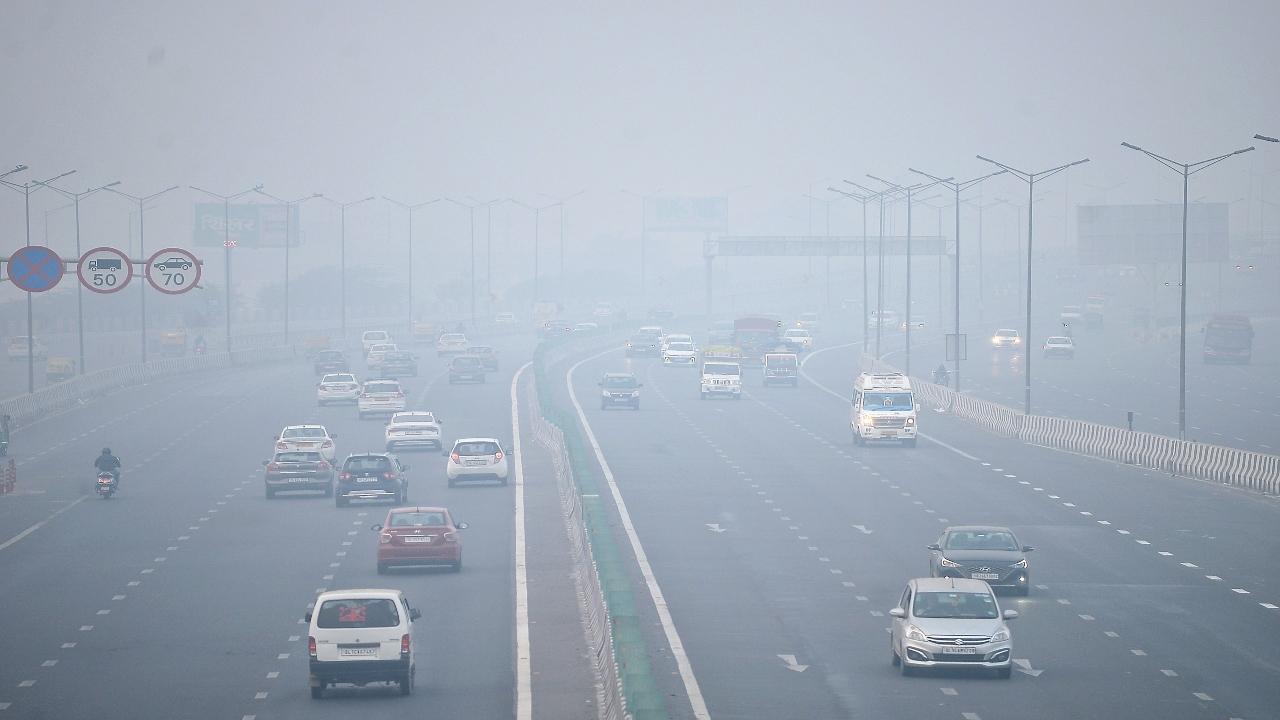After Delhi, Jind in Haryana recorded the second-worst air quality in the country with a reading of 394, while Bahadurgarh, also in the neighbouring state, ranked third with a reading of 388

Pic/PTI
The Delhi air pollution crisis worsened on Saturday with many areas coming in the "severe" category, even as authorities intensified their efforts by imposing penalties totalling around Rs 5.85 crore on the first day of anti-pollution measures under the third stage of the Graded Response Action Plan (GRAP), news agency PTI reported.
ADVERTISEMENT
The city's 24-hour Air Quality Index (AQI), recorded at 4 pm, stood at 417, making it the worst in the country. On Friday, the AQI level was 396.
According to the Central Pollution Control Board (CPCB), air in the "severe" category poses risks to healthy individuals and severely impacts those with existing health conditions.
According to PTI, of the 39 monitoring stations in the national capital, the data shared by CPCB showed that all except for Sri Aurobindo Marg reported air quality in the "severe" category, with AQI levels above 400.
After Delhi, Jind in Haryana recorded the second-worst air quality with a reading of 394, while Bahadurgarh, also in Haryana, ranked third with a reading of 388.
An AQI between 0 and 50 is considered 'good', 51 and 100 'satisfactory', 101 and 200 'moderate', 201 and 300 'poor', 301 and 400 'very poor', 401 and 450 'severe', and above 450 'severe plus'.
Rs 4.85-crore fines collected from motorists in Delhi without PUC certificates
As the third stage of GRAP came into force on Friday, authorities intensified action against violators with teams from the traffic police, transport department, and other agencies issuing fines, PTI reported. On Friday alone, the Delhi Traffic Police issued around 550 challans for violations, including a ban on Bharat Stage (BS)-III petrol and BS-IV diesel vehicles, imposing a fine of more than Rs 1 crore on the first day of restrictions.
A penalty of Rs 20,000 is imposed on those violating this rule. Diesel and petrol inter-state buses, except for BS-VI diesel buses, are also banned from entering the national capital amid the Delhi air pollution crisis.
The police also cracked down on vehicles without Pollution Under Control Certificates (PUCC), issuing fines to 4,855 vehicles, totalling Rs 4.85 crore. A fine of Rs 10,000 is imposed on motorists without a valid PUCC.
During an inspection of buses at the Kashmiri Gate inter-state bus terminal on Saturday, Delhi Environment Minister Gopal Rai alleged that the Bharatiya Janata Party (BJP)-ruled neighbouring states were exacerbating air pollution in the capital by sending BS-IV diesel buses despite the ban.
"The BJP governments are deliberately sending diesel buses to Delhi, which is prohibited under the current guidelines, to worsen air pollution," Rai said, pointing to Haryana, Uttar Pradesh, and Rajasthan.
In response, Rai announced that a total of 84 enforcement teams from the Transport Department and 280 teams from the Traffic Police had been mobilised to ensure strict adherence to the ban.
'Stubble burning was the main contributor to the Delhi air pollution crisis'
Additionally, a stringent ban on construction and demolition activities has been imposed, along with the suspension of mining-related activities and daily water sprinkling on major roads. Schools for classes up to 5 will shift to online mode after the weekend.
The GRAP for Delhi-NCR is divided into four stages based on air quality: Stage 1 for "poor" air quality (AQI ranging from 201 to 300), Stage 2 for "very poor" air quality (AQI from 301 to 400), Stage 3 for "severe" air quality (AQI from 401 to 450), and Stage 4 for "severe plus" air quality (AQI above 450).
Meanwhile, old age homes across the city are intensifying measures to protect the elderly, including strict restrictions on outdoor activities during peak pollution hours, mandatory mask use, and keeping oxygen cylinders on standby for emergencies.
According to the Centre's Decision Support System for Air Quality Management, stubble burning was the main contributor to the Delhi air pollution crisis on Thursday, accounting for 37% of the total pollution. Vehicular emissions contributed approximately 12% to the overall pollution.
The prominent pollutant was PM2.5, according to the CPCB. PM2.5 refers to fine particles with a diameter of 2.5 micrometres or less—about the width of a human hair. These particles are small enough to penetrate deep into the lungs and even enter the bloodstream, posing significant health risks.
(With PTI inputs)
 Subscribe today by clicking the link and stay updated with the latest news!" Click here!
Subscribe today by clicking the link and stay updated with the latest news!" Click here!







